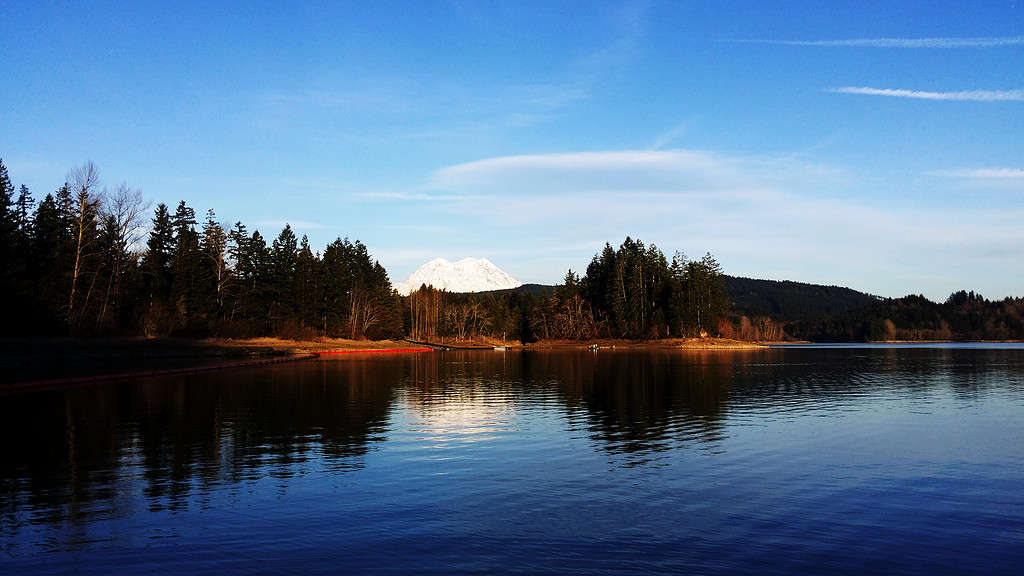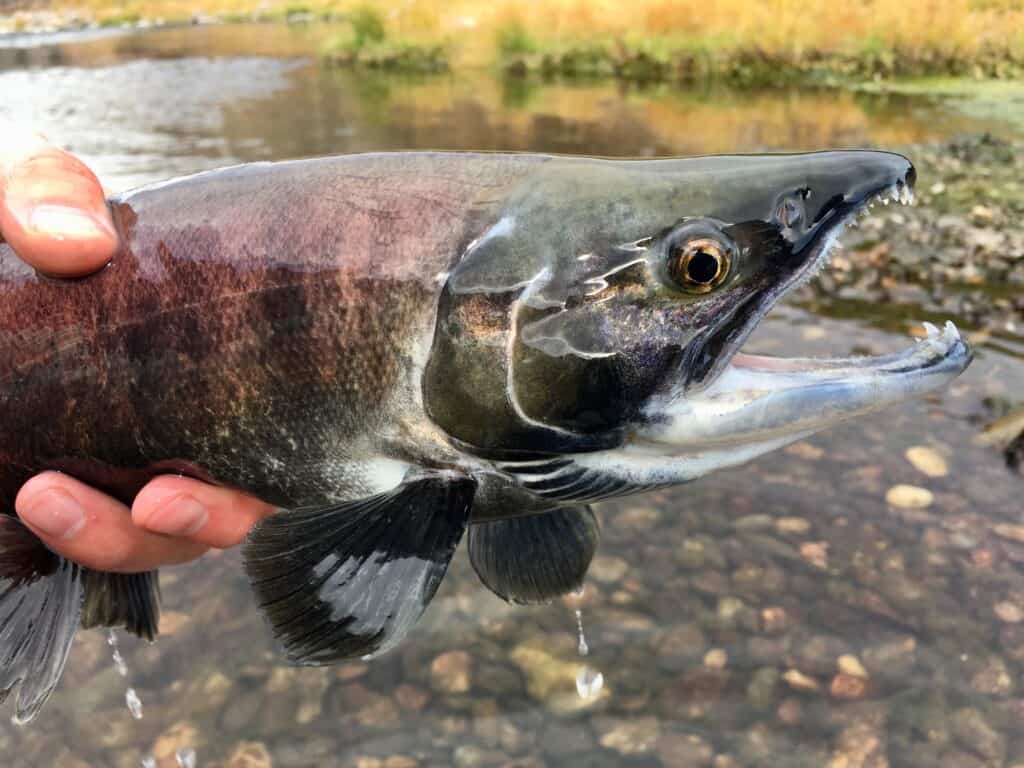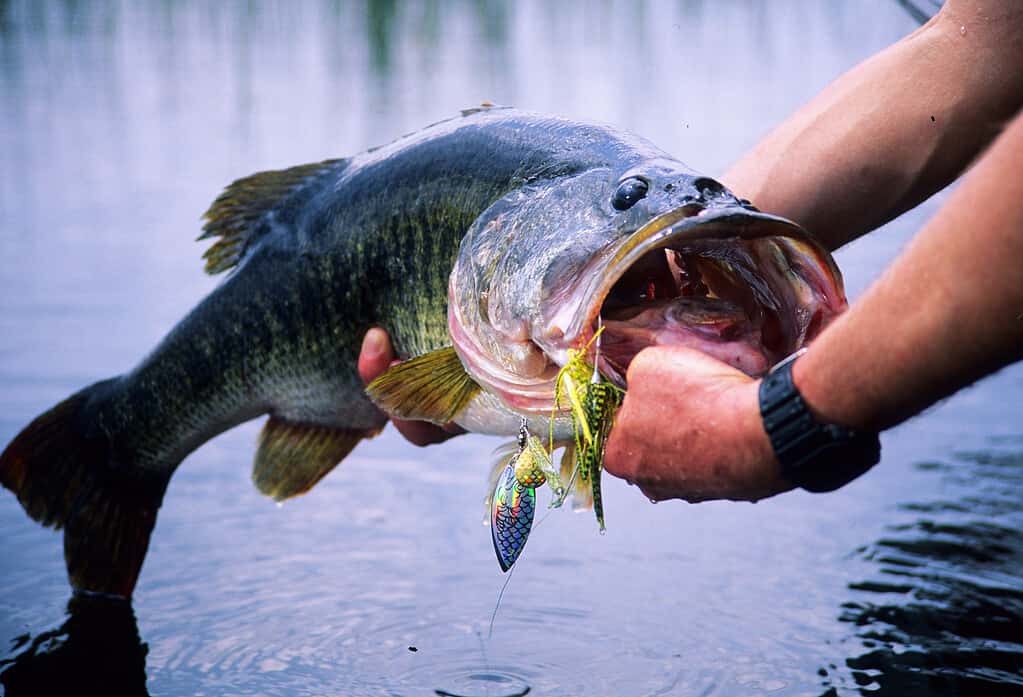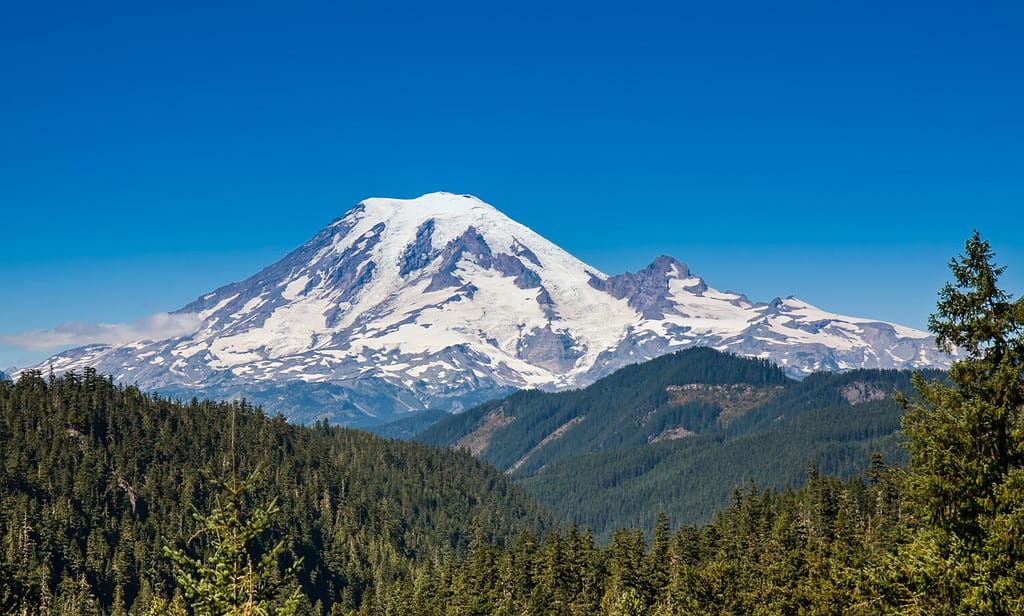Alder Lake in Washington State is a popular spot for anglers, professional and novice. This lake offers a tranquil backdrop for an unforgettable fishing experience because it is surrounded by beautiful forests and a wealth of wildlife. The lake’s crystal-clear waters make it simple to see the fish, which are abundant and ready for capture.
From bass to bluegill and trout, there’s something here for everyone – and with the chance of catching lunkers lurking beneath the surface, there’s plenty of motivation to keep fishing. Regardless of your skill level, Alder Lake promises an exciting day of reeling in a great catch.
Though the Alder Reservoir is open to the public throughout the year, we recommend that you go fishing in the lake from late May to early September (summer months) when the temperatures average 70 degrees Fahrenheit. It is summer when you expect a good harvest of stocked kokanee and other fish species.
Features of Alder Lake
Alder Lake’s most notable features include:
- A surface size of over 2,877.20 acres (12.4 square km)
- A maximum depth of approximately 200 feet
- An elevation of 1,198 feet
Although the lake’s water level varies seasonally, it’s at its best in the spring and early summer. In fall and late summer, it gets too low and may limit the use of boat launches.
The largest part of the lake lies in the boundary between Thurston and Pierce counties and is a day trip from Olympia and Tacoma areas. A small part of the lake is in Lewis County. Alder Lake water remains relatively cold even in summer, thanks to the Nisqually glaciers and those from Mount Rainier and the Cascade Mountains.
The increased amounts of silt from the Nisqually glacier cause the waters of Alder Lake to turn dark in the summer, making it rather difficult to catch fish. Therefore, choose your lure colors well in the summer to catch some fish.

Alder Lake is a 60-minute drive from Tacoma and only a 10-minute drive from Eatonville.
©Eric Friedebach / Flickr – License
Fishing in Alder Lake
Alder Lake is popular because of its easy accessibility It is about a 60-minute drive from Tacoma and only a 10-minute drive from Eatonville. The lake has excellent shoreline access, particularly along SR 7. The best time to fish in Alder Lake is late evening or early morning, and it’s best to use jigs or live baits.
The lake boasts various fish species, including the following:
- Largemouth bass
- Brown bullhead catfish
- Northern pike
- White crappie
- Black crappie
- Yellow perch
- Smallmouth bass
- Coastal cutthroat
Note that you won’t be allowed to retain more than five cutthroat or ten kokanees daily. Besides the fish species mentioned above, the Alder reservoir supports other naturally reproducing fish species.
However, kokanee is the most stocked and fished for species, which the officials stock in large numbers yearly. There are many fishing opportunities in Alder Lake, but some are less appreciated compared to others.
Note that hatchery trout isn’t stocked in the lake, though it is home to many cutthroat trout and is an excellent warm-water fishing sport for the fish species already mentioned.
Kokanee Fishing
The lower part of Alder Lake is perfect for kokanee fishing. This is because the water here is cold, and the depth is good – over 200 feet deep. Early in summer, before the water levels get too low, you can get kokanee almost anywhere in the lake. But as the summer advances and the water gets warmer, kokanee will migrate to the cooler and deeper water.
You’re better off fishing on the main lake close to the dam and Alder Lake Park if you want the best kokanee fishing experience. Kokanee is abundant in the Little Nisqually Arm as well. It is even more interesting to fish in the Little Nisqually Arm because part of it, to the western side of the lake, is a no-wake zone, meaning the water here is calmer than the other parts of the lake, particularly the lake’s main body.
Expert kokanee anglers will tell you it is best to use tiny lures like squid, spoons, or spinners. You can tip your hooks with pieces of worm, maggots, corn, or other bait. Run these lures and bait behind dodgers or attractor blades to draw kokanee.
When a kokanee is close to the water surface, your gear or an additional weight will suffice to sink your trap deep enough. When you finally catch the fish, you will need more weight (about an ounce), down-riggers, and a weighted line to reach the fish. You can also use bait-fishing rigs and some bait similar to the trolling baits to catch kokanee.
For a more enhanced fishing experience, bring along your fish finder to help you identify schools of fish at the proper depths. The best time to catch kokanee is in the morning, though some anglers have reported significant success fishing during the day. With the right gear and good timing, you will catch many kokanees. The authorities stock the lake with over 250,000 young kokanees every year.
If you’re a newbie, it is best to talk with the experts to advise on the best lures and bait.

Whether you’re a seasoned fisherman or just getting started, kokanee fishing is an enjoyable recreational activity that can be enjoyed by all.
©Ryan Cuddy/Shutterstock.com
Trout Fishing
Though Alder Lake isn’t chart-topping for trout fishing, you can do quite well here if you are a fan of trout fishing. And the regulation, such as the 5-trout limit, is something you’ll find easy to achieve, provided you know the right time to hit the water when you can get a good bite.
Alder Reservoir is home to cutthroat trout, which have adapted to the reservoir ecosystem though originally from the Nisqually River. Trolling lures and bait are the best way to catch trout here. Another option is to use casting lures or flies, slow-trolling flies, or natural bait.
Though some are dispersed throughout the lake, you will find many trout close to the food-rich, cooler waters around the creek and river mouths.
There’s no ‘best time’ for catching trout; you can see them all day. However, some anglers prefer fishing trout in the morning.
Panfish and Bass Fishing
You won’t get state-record smallmouth or largemouth bass in Alder Lake. Nevertheless, you will still be able to catch bass weighing several pounds and enjoy the fun. The best place to find largemouth bass is around stumps, logs, and other woody structures. They also like hanging out in coves.
On the other hand, smallmouth bass prefer rocky structures, where their population has grown to the extent that Alder Lake is considered one of the best smallmouth fishing spots in Washington.
Catching bass is easier if you use lures that look like crayfish, smaller fish, or other forage. Alder Reservoir is suitable for schools of panfish. Most anglers have gotten good catches of yellow perch, bluegill, and yellow perch from this reservoir. The yellow perch, in particular, typically attain the best fileting sizes in this lake. The best bait for catching bass is natural bait like flies, jigs, crappies, worms, and small lures.
The best time to catch smallmouth and largemouth bass is in the morning. You can also get a good catch around the afternoon. Still, you can see some smallmouth and largemouth bass any time of the day.

The best time to catch smallmouth and largemouth bass is in the morning.
©iStock.com/stammphoto
Alder Lake Fishing Regulations
Before you start fishing in Alder Lake, it’s prudent to familiarize yourself with the regulations on fishing in this area and have the required fishing license. For example, motor trolling is acceptable in the lake, but only one lure, bait, or hook is allowed per angler. In addition, the authority permits only three lures, baits, or hooks per boat.
Further, you may not be allowed to catch some fish species from this lake. Please confirm that you’re on the right side of the law before you go fishing.
Where to Camp During Your Fishing Expedition
If you plan to stay around Alder Lake for many days, consider camping at Alder Lake Park. You can go fishing in the day and return to your campsite in the evening. Alder Lake Park offers four campgrounds. They include:
- Alder Lake Main Campground
- Osprey Campground
- Elk Plain Campground
- Rocky Point Campground
Main Campground: Alder Lake
Alder Lake’s main campground is ideal for hiking and sightseeing around Mt. Rainier. And it has many sites too. You can choose from tent-only sites or RV sites. You can hike, shoot memorable photos, swim, or relax in your tent. Other activities near the main campground include wildlife watching, paddling, boating, and biking.
Campsite Area
- RV or tent sites
- 78 sites
- Allows up to six vehicles and eight persons per site
- Lacks wheelchair access
Essentials and Amenities
- Picnic table
- Hot Showers
- Portable table
- Pets allowed
- Lively campfires
- Functional toilet
Osprey Campground
Osprey Campground is smaller but cozier than the main campground, though it is a tents-only campground. So, if you like firing up your RV, you better look elsewhere. This campsite has something for everyone; from sightseeing and swimming to paddling and wildlife watching, there’s something to keep everyone busy.
The campsite is about one-and-a-half hours from Seattle and only 60 minutes from Tacoma.
Campsite Area
- Tent sites
- 81 sites
- Allows up to six vehicles and eight persons per site
- Lacks wheelchair access
Essentials and Amenities
- Picnic table
- Showers
- Portable table allowed
- Functional toilet
- Campfires allowed
- Pets allowed
Campsite Area
- Tent sites
- 81 sites
- Allows up to six vehicles and eight persons per site
- Lacks wheelchair access
Essentials and Amenities
- Picnic table available
- Showers available
- Potable water provided
- Toilet available
- Campfires allowed
- Pets allowed
Elk Plain Campground
Elk Plain Campground provides a stunning view of the nifty dam, explaining why many campers choose it. This campsite is smaller than the main one but has much to offer. For example, the camp is covered by trees, making it cooler than other campsites. The campsite surrounds a playground. So you can decide to enjoy a swing after your fishing expedition.
Generally, this campsite is comfortable, making it another wonderful home away from home.
Campsite Area
- RV or tent sites
- 25 sites allowing up to six vehicles and eight guests per site
- Lacks wheelchair access
Essentials and Amenities
- Picnic table available
- Potable water provided
- Campfires allowed
- Pets allowed
- Toilet available
Rocky Point Campground

Most campers and fishermen like Rocky Point Campground because of its proximity to Mount Rainier National Park.
©picturin/Shutterstock.com
Nisqually River Project owns and operates Rocky Point and Alder Lake Park. The Rocky Point campsite has something for everyone, whether you like traditional tent camping or want more comfort like sewer, electricity, and water hookups.
Rocky Point Campground is a great option if you like quieter places. It’s not noisy because it’s far from the main campsite. It also has a generous tree cover, making it perfectly secluded. The main beach here is a little rocky, but there’s an option if you don’t prefer rocky beach – you can enjoy yourself at Sunny Beach Point, which is less rocky.
Most campers and fishermen like Rocky Point Campground because of its proximity to Mount Rainier National Park. So, as you plan your expedition, include a visit to this national park.
Campsite Area
- RV or Tent sites
- 25 sites allowing up to six vehicles and eight guests per site
- Picnic table available
- Potable water provided
- Lacks wheelchair access
- Pets allowed
- Campfires allowed
All these sites are above average in terms of facilities and other amenities. You can choose any of these campsites as your fishing base. You’ll love these campsites’ ease of access, especially the Sunny Beach Point entry point. In addition, the grounds offer a great camping base to explore all the lakes in this area and explore the Alder Dam Viewpoint that offers quite the view.
Overall, the Alder Lake area is an excellent place to camp for as long as you wish, though you will get good company in the summer months (May and June).
Nearby Sites Worth Visiting
Take your pick of four campsites at Alder Lake – there’s plenty of room for everyone! And while you’re there, explore the Alder Lake Loop Trail, a one-and-a-half-mile state-maintained trail that circles the lake.
Note also that you can swim in Alder Lake though it has no lifeguard or beach. You’ll therefore have to be careful. Additionally, the authority allows non-motorized boating in this lake. Whatever you do, it’s best not to be alone. Also don’t forget to provide a trusted person with your emergency contacts before you venture into the lake.
An Unforgettable Angling Experience Awaits You at Alder Lake
Alder Lake in Washington is ideal for fishing, explaining why it is busy almost yearly. When you plan to camp here, ensure you carry everything that you need to stay safe and comfortable. Also, don’t forget your fishing gear and any items you need to make your expedition more exciting. However, it is worth emphasizing that compliance with the Alder Lake fishing regulations is paramount. If you aren’t sure about anything, it’s advisable to ask for guidance.
Alder Lake fishing is a vibrant outdoor experience that offers a wide variety of angling options. From the shallow depths of the northwest shore to the deep, expansive waters of the southwest bay there’s something for every fisherman.
This lake is ripe with life and opportunity for a thrilling outdoors adventure. Whether seeking to catch the freshest fish around, or just enjoying a pristine natural setting, Alder Lake fishing is sure to provide an unforgettable experience for all.
The photo featured at the top of this post is © Rocksweeper/Shutterstock.com
Thank you for reading! Have some feedback for us? Contact the AZ Animals editorial team.






